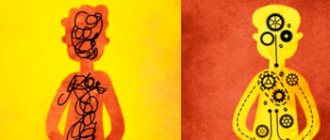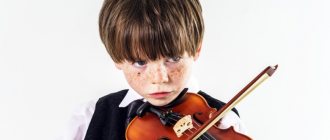Thinking is determined by a person’s needs, his interests, motives, tasks, goals, that is, a person’s thinking is purposeful in nature, associated with the needs and motivation of a particular individual.
A person’s individual thinking is directly related to his mind, but the concept of mind is broader: it includes features of both thinking and other cognitive processes. Thinking is the processing of information, a set of interconnected sensations, thoughts, and images. As a result, it gives us an idea of how everything in nature relates to each other. Thinking is a tool of the mind, one of its prerequisites. The mind is the repository of knowledge, intelligence, intuition, personality traits (its beliefs, positions, programs), it determines a person’s ability to think and solve emerging problems.
A person’s upbringing, his training, the chosen type of occupation, preferences, and the uniqueness of life constitute the features of the individual characteristics of a person’s thinking. Age, the type of higher nervous activity, and the ratio of the first and second signaling systems are also important. You can read more about types of thinking in our blog:
Two levels of individual characteristics of human thinking
Individual characteristics of human thinking in psychology are analyzed at two different levels: the individual and the personality.
When talking about a person as an individual, we consider certain neurodynamic characteristics and processes. We are talking about the following:
- How do the first and second signaling systems relate and, accordingly, what type of thinking, artistic or mental, predominates.
- How nervous processes proceed: the speed of acquiring knowledge, mental performance, and human sensitivity depend on their strength or weakness. The speed of thinking and its flexibility or, on the contrary, difficulty depend on their activity or, on the contrary, inertia.
Personal factors of thinking include:
1. Installation (operational and semantic).
Operating is the readiness to take some steps, while relying on previous experience and assuming the development of events taking into account existing conditions.
Semantic – a higher level setting. It acts as a kind of filter that corrects operating settings. Meaningful attitudes determine the content, pace of development, and performance of the individual as a whole.
2.Motives. They activate and structure thinking. Meaningful motivation imparts valuable personal meaning to thinking.
3.Emotions. They help evaluate information, activate thinking, reduce the time required to find a solution to a problem, and generate new information. perform four functions: evaluative, activating, the function of heuristics (techniques that reduce the time of searching for a solution to a problem), the function of a generator of new information.
4.Personal past experience. It is concentrated in a person’s knowledge and determines the characteristics of his thinking. Only well-structured knowledge turns a person into an intellectual and distinguishes him from an amateur.
5. Socio-psychological factors. Thus, the authoritarianism of teachers and parents gives rise to stereotypical thinking, absence or low level of creativity. On the contrary, parity in relationships creates the preconditions for independence, criticality, originality of thinking, the ability to take into account the position of another person and, as a result, for creative productivity.
Basic qualities of human thinking
Individual characteristics of thinking in psychology are usually determined by the following qualities:
- Logicity is the ability to follow a certain sequence when considering a question, i.e. order determined by logic. This is the ability to think, prove the correctness or fallacy of a conclusion, and check the course of reasoning.
- Depth of thinking (thoughtfulness) is the ability to find the essence, the main thing, the most essential, often hidden. This is the ability to understand not appearance, but essence; formulate an idea based on a variety of facts, understand as a whole, notice patterns, understand the causes and anticipate the consequences.
- Broadness of thinking is the ability to consider problems from all sides, interconnected with other phenomena and sufficiently critical, covering different areas of knowledge.
- Flexibility (plasticity) – the ability to change ways of solving problems in changing circumstances. Flexibility of thinking allows us to consider phenomena and objects, relationships and properties in different aspects. If conditions change, flexible thinking allows you to restructure the initial data and use their relativity. When new inputs are received, plans change to take them into account, as a result of which the plan for solving the problem also successfully changes. This property is associated with the mobility of thought processes.
- Inertia of thinking is the opposite of flexibility. Inert thinking does not look for new ways, preferring to reproduce what has already been learned and known, that is, it is a tendency to think in stereotypes when a person experiences difficulties when it is necessary to switch to another system of actions.
- Originality of thinking is a person’s ability to pose new questions; use known experience, and at the same time show independence of judgment and find an independent solution. Independence, originality of thinking presupposes self-criticism (knowledge of one’s strengths and weaknesses). Independence also reveals the creative nature of thinking.
- Critical thinking is the desire to evaluate objectively, apply only proven judgments, and carefully check objections before discarding them. It involves the ability to identify the advantages and disadvantages of reasoning and prove the truth of the propositions put forward.
- Speed of thinking is the speed at which thought processes occur. It manifests itself in the amount of time needed to solve problems and in the ease of implementing ideas. Quick thinking is especially important in critical situations, when you need to make a decision very quickly and take action.
- Clarity of thinking is simplicity, sincerity, and uncomplicated expression of thoughts.
- Inquisitiveness is the need to find the most suitable solution to a problem.
- Wit is the ability to quickly navigate the material and find the right solutions to problems.
- Initiative is the desire to search and find a solution to a problem independently, in a wide variety of ways and means.
- Originality is the ability to generate new ideas that are different from those already familiar.
In psychology, the following are also identified as individual characteristics of thinking:
- The pace of development of thought processes, which is understood as the least amount of exercise that is required in order to understand and generalize the principle of the solution.
- Economy of thinking is the number of sequential reasoning that allows one to learn a new pattern.
- Stability is the preservation of a focus on previously identified important features and generally accepted patterns.
- Awareness is the ability to verbally express both the result of the work done and the techniques that were used.
All individual characteristics of a person’s thinking are important for the correct assessment of his abilities and knowledge. But the fundamental sign of thinking is the ability to identify the main thing, the most essential, in order to then, thinking independently, move to new generalizations. Thinking is much more than a statement of an event or a fact. His path is to delve into the essence of a phenomenon and discover the general law of development of all somewhat homogeneous phenomena, no matter what their external differences.
Cognitive qualities of thinking are individual in nature and undergo changes with age, but the main thing is that they can be corrected, their performance can and should be improved. Thanks to the plasticity property of the brain, its cognitive functions can be developed at any age. Thinking and attention, memory, perception can be trained daily, with pleasure and benefit using exercises for the development of thinking in adults.
Article:
Junior school age (from 6-7 to 9-10 years) is determined by an important external circumstance in the child’s life - entering school.
A child who enters school automatically takes a completely new place in the system of human relations: he has permanent responsibilities associated with educational activities. Close adults, a teacher, even strangers communicate with the child not only as a unique person, but also as a person who has taken upon himself the obligation (whether freely or under compulsion) to study, like all children of his age. By the end of preschool age, the child is, in a certain sense, an individual. He is aware of what place he occupies among people (he, a preschooler) and what place he will have to take in the near future (he will go to school). In a word, he discovers a new place for himself in the social space of human relations.
At this age, a significant achievement in the development of a child’s personality is the predominance of the “I must” motive over the “I want” motive.
A child in primary school learns special psychophysical and mental actions that should serve writing, arithmetic operations, reading, physical education, drawing, manual labor and other types of educational activities. Based on educational activities, under favorable learning conditions and a sufficient level of mental development of the child, prerequisites for theoretical consciousness and thinking arise.
At the same time, educational activity requires special reflection from the child associated with mental operations: analysis of educational tasks, control and organization of executive actions, as well as control over attention, mnemonic actions, mental planning and problem solving.
The new social situation introduces the child into a strictly standardized world of relationships and requires from him organized arbitrariness, responsible for discipline, for the development of performing actions associated with acquiring skills in educational activities, as well as for mental development. Thus, the new social situation tightens the child’s living conditions and acts as stressful for him. Every child who enters school experiences increased mental tension. This affects not only physical health, but also the child’s behavior.
At school, the child’s living conditions are standardized; as a result, many deviations from the intended path of development are revealed: hyperexcitability, hyperdynamia, severe inhibition. These deviations form the basis of children's fears, reduce volitional activity, cause depression, etc. The child will have to overcome the trials that have befallen him.
General sensitivity to the influence of environmental living conditions, characteristic of childhood, promotes the development of adaptive forms of behavior, reflection and mental functions. In most cases, the child adapts himself to standard conditions.
The leading activity is educational. In addition to mastering special mental actions and actions related to writing, reading, drawing, labor, etc., the child, under the guidance of a teacher, begins to master the content of the basic forms of human consciousness (science, art, morality, etc.) and learns to act in accordance with traditions and new ones. people's social expectations.
Educational activities require new achievements from the child in the development of speech, attention, memory, imagination and thinking; creates new conditions for the child’s personal development.
The difference between thinking and other psychological processes is that it is almost always associated with the presence of a problem situation, a task that needs to be solved, and an active change in the conditions in which this task is given. Thinking, unlike perception, goes beyond the limits of the sensory data and expands the boundaries of knowledge. In thinking based on sensory information, certain theoretical and practical conclusions are made. It reflects existence not only in the form of individual things, phenomena and their properties, but also determines the connections that exist between them, which most often are not given directly to man in his very perception.
Thinking occurs according to laws common to all people; at the same time, the age and individual characteristics of a person are manifested in thinking.
Many authors recognize that for mental development, mastering a system of knowledge and mental operations (A.N. Leontiev, V.S. Shardakov, N.I. Grebtsova, etc.), intellectual skills (P.Ya. Galperin, N. A. Menchinskaya, A.E. Vokhmyanina, etc.), techniques of mental activity (A.Z. Zak, L.M. Friedman, etc.). However, the question of the influence of thinking techniques on the mental development of students (especially of primary school age) remains not fully resolved.
The first feature of thinking is its indirect nature. What a person cannot know directly, directly, he knows indirectly, indirectly: some properties through others, the unknown through the known. Thinking is always based on the data of sensory experience - sensations, perceptions, ideas - and on previously acquired theoretical knowledge. Indirect knowledge is mediated knowledge. The second feature of thinking is its generality. Generalization as knowledge of the general and essential in the objects of reality is possible because all the properties of these objects are connected with each other. The general exists and manifests itself only in the individual, in the concrete.
Thinking is a special kind of theoretical and practical activity that involves a system of actions and operations included in it of an indicative, research, transformative and cognitive nature.
Thinking is the highest level of human knowledge of reality. The sensory basis of thinking is sensations, perceptions and ideas. Through the senses - these are the only channels of communication between the body and the outside world - information enters the brain. The content of information is processed by the brain. The most complex (logical) form of information processing is the activity of thinking. Solving the mental problems that life poses to a person, he reflects, draws conclusions and thereby learns the essence of things and phenomena, discovers the laws of their connection, and then transforms the world on this basis. Thinking is not only closely connected with sensations and perceptions, but it is formed on the basis of them. The transition from sensation to thought is a complex process, which consists, first of all, in isolating and isolating an object or its sign, in abstracting from the concrete, individual and establishing the essential, common to many objects.
Thinking is inextricably linked with speech mechanisms, especially speech-auditory and speech-motor mechanisms. Thinking is also inextricably linked with the practical activities of people. Every type of activity involves thinking, taking into account the conditions of action, planning, and observation. By acting, a person solves some problems. Practical activity is the main condition for the emergence and development of thinking, as well as a criterion for the truth of thinking.
Thinking is a function of the brain, the result of its analytical and synthetic activity. It is ensured by the operation of both signaling systems with the leading role of the second signaling system.
Human mental activity is the solution of various mental problems aimed at revealing the essence of something. A mental operation is one of the methods of mental activity through which a person solves mental problems.
Mental operations are varied. This is analysis and synthesis, comparison, abstraction, specification, generalization, classification. Which logical operations a person will use will depend on the task and on the nature of the information that he is subjected to mental processing.
Analysis is the mental decomposition of a whole into parts or the mental isolation of its sides, actions, and relationships from the whole. Synthesis is the opposite process of thought to analysis; it is the combination of parts, properties, actions, relationships into one whole. Analysis and synthesis are two interrelated logical operations. Synthesis, like analysis, can be both practical and mental. Analysis and synthesis were formed in the practical activities of man.
Comparison is the establishment of similarities and differences between objects and phenomena. The comparison is based on analysis. Before comparing objects, it is necessary to identify one or more of their characteristics by which the comparison will be made. The comparison can be one-sided, or incomplete, and multilateral, or more complete. Comparison, like analysis and synthesis, can be at different levels - superficial and deeper.
Abstraction is the process of mental abstraction from certain features, aspects of a particular thing in order to better understand it. A person mentally identifies some feature of an object and examines it in isolation from all other features, temporarily distracting from them. Isolated study of individual features of an object while simultaneously abstracting from all others helps a person to better understand the essence of things and phenomena. Thanks to abstraction, man was able to break away from the individual, concrete and rise to the highest level of knowledge - scientific theoretical thinking.
Concretization is a process that is the opposite of abstraction and is inextricably linked with it. Concretization is the return of thought from the general and abstract to the concrete in order to reveal the content. Mental activity is always aimed at obtaining some result. A person analyzes objects, compares them, abstracts individual properties in order to identify what they have in common, in order to reveal the patterns that govern their development, in order to master them.
Generalization, therefore, is the identification of the general in objects and phenomena, which is expressed in the form of a concept, law, rule, formula, etc.
The thinking of a primary school student is a generalized reflection of reality, carried out through words and mediated by existing knowledge, and is closely related to sensory knowledge of the world.
A feature of a child’s healthy psyche is cognitive activity. A child’s curiosity is constantly aimed at understanding the world around him and building his own picture of this world. The child, while playing, experiments, tries to establish cause-and-effect relationships and dependencies. He himself, for example, can find out which objects will sink and which will float.
The more mentally active a child is, the more questions he asks and the more varied these questions are. A child may be interested in everything in the world: how deep is the ocean? How do animals breathe there? how many thousand kilometers is the globe? Why doesn’t the snow melt in the mountains, but does it melt below?
The child strives for knowledge, and the acquisition of knowledge itself occurs through numerous “why?”, “how?”, “why?” He is forced to operate with knowledge, imagine situations and try to find a possible way to answer the question. We have already said that when some problems arise, the child tries to solve them by actually trying them on and trying them out, but he can also solve problems, as they say, in his mind. He imagines a real situation and, as it were, acts in it in his imagination. Such thinking, in which the solution of a problem occurs as a result of internal actions with images, is called visual-figurative. Imaginative thinking is the main type of thinking in primary school age. Of course, a junior schoolchild can think logically, but it should be remembered that this age is sensitive to learning based on visualization.
A child’s thinking at the beginning of school is characterized by egocentrism, a special mental position caused by the lack of knowledge necessary to correctly solve certain problem situations. Thus, the child himself does not discover in his personal experience knowledge about the preservation of such properties of objects as length, volume, weight, etc. The lack of systematic knowledge and insufficient development of concepts lead to the fact that the logic of perception dominates in the child’s thinking. For example, it is difficult for a child to evaluate the same amount of water, sand, plasticine, etc. as equal (the same thing), when before his eyes their configuration changes in accordance with the shape of the vessel where they are placed. The child becomes dependent on what he sees at each new moment of changing objects. However, in the elementary grades, a child can already mentally compare individual facts, combine them into a holistic picture, and even form for himself abstract knowledge that is distant from direct sources.
J. Piaget established that the thinking of a child at six or seven years old is characterized by “centring” or perception of the world of things and their properties from the only possible position for the child, the position he actually occupies. It is difficult for a child to imagine that his vision of the world does not coincide with how other people perceive this world. At this age, it is difficult for a child to imagine that there may be a different point of view, that one can see in different ways.
J. Piaget described studies that indicate a child’s lack of understanding of the constancy of certain properties of things as a characteristic feature of children under six or seven years of age. Experiments with plasticine balls are classic.
If you put two completely identical plasticine balls in front of a child, the child will immediately establish that they are the same in terms of the amount of plasticine mass. It is worth, however, in front of the child's eyes, crush one ball into a cake and then ask where there is more plasticine, the child will immediately answer that there is more plasticine in the cake.
Of course, in modern society, the mental development of a child depends on the type of construction of new knowledge. It is built by an adult who has already formed intelligence. We are talking about scientific knowledge. Intellectual development is determined by social factors - the individual is changed by social relations.
The transition to systematic education at school, to developmental education, changes the child’s orientation in the phenomena of reality around him. At the pre-scientific stage of development of thinking, the child judges changes from an egocentric position, but the transition to mastering new ways of solving problems changes the child’s consciousness, his position in assessing objects and changes occurring to him. Developmental education leads the child to master the scientific picture of the world; he begins to focus on socially developed criteria.
Among the many concepts describing the development of thinking in ontogenesis, one of the most popular and productive is the genetic classification, which states that visual-effective, visual-figurative and verbal-logical thinking form stages in the development of thinking in ontogenesis and phylogenesis.
According to these ideas, initially the child solves mental problems by directly acting with an object, and only later does he acquire the ability to operate with images, and then with symbols and abstract, generalized concepts.
Consequently, genetically, the first way for a child to understand the world around him is the process of physical interaction with it; over time, it gives way to figurative cognition, which is relatively free from direct actions.
Subsequently, the following method is formed, which involves the translation of actions and images into linguistic means. In this way, a higher level of analysis and generalization is achieved - the mechanisms of theoretical thinking are turned on.
As this diagram clearly shows, at the first stage of development of children's thinking, the role of exploratory behavior is extremely important.
The subsequent stages - the formation of imaginative and then theoretical thinking - do not in any way detract from its significance. They gradually bring the child’s exploratory behavior to qualitatively different, higher levels.
Naturally, the development of a child’s thinking is not carried out simply by passing through these stages. It represents his consistent mastery of three spheres of representation: actions, images and symbols. First, the child learns about the world through his own practical (objective) actions. Then the world is presented and mastered in images that are relatively free from action, and only this experience creates the basis for translating action and image into linguistic means.
1. At the same time, the earliest and simplest type of thinking is the child’s visual-effective (objectively-active) thinking, which is “captive” of the situation and action, i.e. unable to be carried out without relying on “contemplation” of the situation and the ability to act in it. This kind of thinking is also called manual thinking. Low criticality towards one’s actions, lack of a hierarchy of characteristics such as particular - general, genus - species, opposition - these indicators are not always effective if they are not supported by verbal thinking
2. By improving, thinking is gradually freed, “emancipated” from the captivity of a real, specific situation. Instead of operating with objects, thinking begins to operate with their images. This is how visual-figurative thinking arises (for preschoolers 4-7 years old).
It also becomes possible to mentally perform operations that are not feasible in reality. An abundance of private connections, randomness in the choice of features, a large share of subjectivity with a predominance of emotional components
3. In the course of further improvement, thinking refuses to operate with objects entirely and moves on to the use of concepts, logical structures that do not have a direct figurative expression (honesty, pride, etc.). From the moment of entering school, verbal and logical thinking arises. The transition to this new form of thinking is associated with a change in the content of thinking: now these are no longer specific ideas that have a visual basis and reflect the external characteristics of objects, but concepts that reflect the most essential properties of objects and phenomena and the relationships between them. Verbal-logical, conceptual thinking is formed gradually throughout primary school age. Verbal-logical thinking allows the student to solve problems and draw conclusions, focusing not on visual signs of objects, but on internal, essential properties and relationships. During training, children master the techniques of mental activity, acquire the ability to act “in their minds” and analyze the process of their own reasoning. The child develops logically correct reasoning: when reasoning, he uses the operations of analysis, synthesis, comparison, classification, and generalization.
In psychological science, there are such forms of thinking as:
concepts, judgments, conclusions.
A concept is a reflection in the human mind of the general and essential properties of an object or phenomenon. A concept is a form of thinking that reflects the general and, moreover, essential properties of objects and phenomena. Each object, each phenomenon has many different properties, signs. These properties, signs can be divided into two categories - essential and non-essential. The concept acts both as a form of thinking and as a special mental action. Behind each concept there is a special objective action hidden. Concepts can be:
general and individual;
concrete and abstract;
empirical and theoretical.
A general concept is a thought that reflects the general, essential and distinctive (specific) characteristics of objects and phenomena of reality. A single concept is a thought that reflects the characteristics inherent only to a separate object and phenomenon. Depending on the type of abstraction and generalizations underlying them, concepts are empirical or theoretical. The specific content of the theoretical concept is the objective connection between the universal and the individual (whole and different). Concepts are formed in socio-historical experience. A person acquires a system of concepts in the process of life and activity.
A concept exists in the form of the meaning of a word and is denoted by a word. Each word generalizes (except, of course, words denoting proper names). In concepts, our knowledge about objects and phenomena of reality crystallizes in a generalized and abstract form. In this respect, the concept differs significantly from the perception and representation of memory: perception and representation are concrete, figurative, and visual; the concept has a generalized, abstract, non-visual character.
The content of concepts is revealed in judgments, which are always expressed in verbal form - oral or written, out loud or silently. Judgment is the main form of thinking, during which connections between objects and phenomena of reality are affirmed or denied. Judgment is a reflection of the connections between objects and phenomena of reality or between their properties and characteristics. Judgment is a form of thinking that contains the affirmation or denial of any position regarding objects, phenomena or their properties.
Judgments can be:
true;
false;
general;
private;
single.
True judgments are objectively true judgments. False judgments are judgments that do not correspond to objective reality. Judgments can be general, particular and individual. In general judgments, something is affirmed (or denied) regarding all objects of a given group, a given class, for example: “All fish breathe with gills.” In private judgments, affirmation or negation no longer applies to all, but only to some subjects, for example: “Some students are excellent students.” In single judgments - to only one, for example: “This student did not learn the lesson well.”
Inference is the derivation of a new judgment from one or more judgments. Inference is a form of thinking in which a person, comparing and analyzing various judgments, derives a new judgment from them. A typical example of inference is the proof of geometric theorems.
The initial judgments from which another judgment is derived are called premises of the inference. The simplest and typical form of inference based on particular and general premises is a syllogism. An example of a syllogism is the following reasoning: “All metals are electrically conductive. Tin is a metal. Therefore, tin is electrically conductive.” There are inferences:
inductive;
deductive;
Similarly.
An inductive conclusion is one in which reasoning proceeds from individual facts to a general conclusion. A deductive conclusion is one in which reasoning is carried out in the reverse order of induction, i.e. from general facts to a single conclusion. An analogy is an inference in which a conclusion is drawn on the basis of partial similarities between phenomena, without sufficient examination of all conditions.
Theoretical explanation, abstract theories in abstract concepts and the same abstract laws are still inaccessible at this stage of development of thinking. In the unity of representation and concept, representation is still dominant. All of the child’s thinking—concepts, judgments, and inferences accessible to him—receives a new structure at this stage of development.
Mastery of concepts. Children master scientific concepts during the learning process. The process of mastering the generalized conceptual content of scientific knowledge that has developed in the course of historical development is, at the same time, a process of developing children’s ability to generalize. The development of a child’s ability to generalize is both a prerequisite and a consequence of his mental activity, aimed at mastering the content of scientific concepts, is realized by the child with varying degrees of depth and adequacy of penetration into it, and is accomplished as if by ledges. The level of children’s assimilation of various concepts significantly depends on the level of generalization contained in the corresponding concept, on the proximity or distance from the visual content, on the contiguity of its mediation.
The reason or reason for developing such erroneous concepts is largely the imperfection of the pedagogical process. Most studies examining how children acquire concepts have used the definitional method. The method of definitions does not reveal the true development of concepts, but only takes into account their existing composition; However, it does not always give an adequate picture of the mastery of concepts. Children usually operate better with concepts rather than define them, because the child primarily masters concepts not terminologically, but in specific mental operations, applying them in various contexts. However, even the definitional method reveals a large qualitative shift in the thinking of a schoolchild compared to a preschooler. The main line of development of thinking is manifested in the fact that definitions, that is, the disclosure of the content of a concept, are increasingly liberated from being conditioned by the subject and from being bound by the immediate situation; definitions of concepts are becoming more objective and indirect. The first attempt to define an object not only by its relation to the subject, bypassing the objective relations of objects to each other, and not only through visual signs, is represented by logical definitions through a generic concept. This definition in its structure is close to the definitions of formal logic. It includes an object in a class of homogeneous ones, and not in a system of objects or concepts associated with it. According to a number of researchers, this type of definition prevails mainly among younger schoolchildren from 7 to 10 - 11 years old.
At the same time, the insufficiency of generalization in children at first is manifested in the fact that they often indicate not a specific sign, but a particular one. In such definitions, the child, using general concepts, nevertheless finds himself bound by a particular situation directly given to him: for one, a cousin is the son of an uncle, for another, an aunt, for one, an aunt is a mother’s sister, for another, a father’s sister.
A higher form of definition is definition through the inclusion of a concept in the system of objective connections that define it (instead of formal relations of subordination). These are the so-called genetic definitions, which define a physical phenomenon through its connection with the causes that give rise to it or an abstract concept through a system of relations essential to it. And such definitions may not be completely general.
The role of definition through example decreases sharply as the student develops abstract thinking. Since the path to generalization lies through the disclosure of connections and relationships, this form of definition opens up great opportunities for generalization and facilitates the transition to the stage of an adequate definition of a concept, including everything and only that which is objectively essential. Various forms of definition coexist in a child’s real thinking.
Judgments and inferences. In the development of a child’s judgments, an essential role is played by the expansion of knowledge and the development of a mindset of truth. It is consolidated at school age by training, during which the child is given knowledge and is required to answer, which are assessed from the point of view of their correctness. But while cognitive penetration into the subject is shallow, what comes from an authoritative source and therefore seems reliable (“the teacher said”, “it’s written in the book”) is easily recognized as true. The situation changes as cognitive penetration into the subject deepens, and in connection with the growth of consciousness, the child begins to establish his internal attitude towards the truth of his judgments.
Primary school age is usually characterized by a strict realism of attitudes, the dominance of interest in specific facts of objective reality (manifested in collecting, compiling herbariums, etc.. Specific facts are at the center of the child’s intellectual interests. This affects the content and structure of his judgments. They occupy a significant place , in the language of dialectical logic, "judgments of existence" and "judgments of reflection"; of the "judgments of the concept" predominantly assertoric, much weaker problematic and apodictic are presented. The evidence itself, to which the child resorts, often comes down to a reference to an example. Link for example, and analogy are typical techniques, “methods” of proof for a small schoolchild. The very common idea that a child’s thinking is characterized primarily by an inability to reveal connections and give explanations is clearly untenable; observations refute it. Rather, a child is characterized by ease , with which he makes connections and accepts any coincidences as explanations. The child's thought first works in short circuits. Only as the child, separating the conceivable from the actual, begins to consider his thought as a hypothesis, that is, a position that still needs to be verified, does the judgment turn into reasoning and is included in the process of justification and inference.
According to a number of studies, primary schoolchildren show significant development in their ability to make inferences. At the first school age (7 - 10 years), inductive and deductive conclusions are formed, revealing deeper objective connections than transduction in a preschooler. But even in this period: 1) inferences are limited primarily by the premises given in observation. More abstract inferences are for the most part accessible, mainly only insofar as they can be made with the help of a visual diagram, such as, for example, inferences about the relationship of quantities; 2) inferences, since they are objective, are made in accordance with certain principles or rules, but not on the basis of these principles: these general principles are not realized. Since the logical necessity of inference is not realized, the entire path of reasoning is for the most part inaccessible to understanding.
Operating already at this stage with diverse concepts of things, phenomena, processes, the child’s thinking is thus prepared to understand the concepts themselves in their properties and relationships. Thus, within this stage of thinking, prerequisites and opportunities are created for the transition to the next stage. These possibilities are realized in the child as he masters a system of theoretical knowledge during his education.
Conclusions:
- At primary school age:
- further physical and psychophysiological development of the child occurs, providing the opportunity for systematic learning at school;
- the child becomes a “social” subject and now has socially significant responsibilities, the fulfillment of which receives public assessment;
- educational activity becomes leading;
- voluntary behavior appears;
- the possibility of planning the results of action and reflection appears;
- There is an increase in children's desire to achieve.
- Thinking is a special kind of theoretical and practical activity that involves a system of actions and operations included in it of an indicative, research, transformative and cognitive nature.
- Peculiarities of thinking of younger schoolchildren:
– the thinking of a junior schoolchild is characterized by high rates of development;
– structural and qualitative transformations occur in intellectual processes;
– visual-effective and visual-figurative thinking are actively developing, verbal-logical thinking begins to form.
- At primary school age, all three forms of thinking develop (concept, judgment, inference):
– children master scientific concepts during the learning process;
– in the development of a child’s judgments, an essential role is played by the expansion of knowledge and the development of a mindset of truth;
– a judgment turns into a conclusion as the child, separating the thinkable from the actual, begins to consider his thought as a hypothesis, that is, a position that still needs to be verified.








